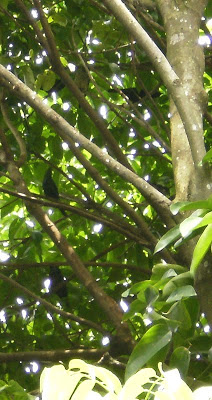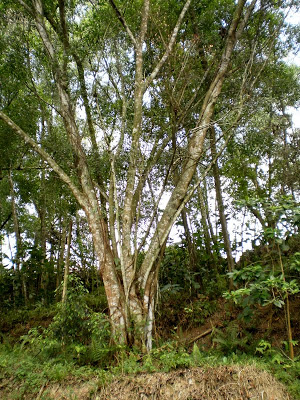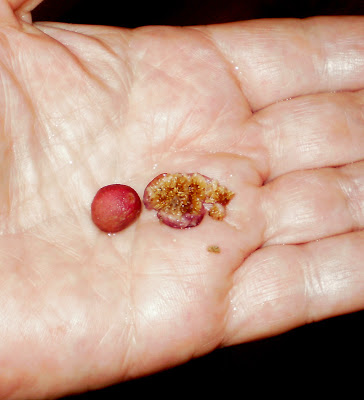
I am home, sitting at my desk, immersed in the proofs – yes, still doing those – when I become aware of a dense and frenetic chattering ouside, heard even over the sound of the fan and Beethoven Radio. I drag myself away from a desert landscape where birds are few and far between, with the feeling that I have suddenly been deposited in the midst of a bird roost. I have never heard anything like this in my own yard.
I go outside – and yes, I am indeed in the middle of a flock of birds. And I am not talking ten or twenty birds. I am talking hundreds. Four, five hundred? More? Possibly. The leaves are thick, and the birds are hard to count.
We have a line of trees, palms and huge bamboos planted along one side of the house and every single one of the trees is alive with fluttering, dancing leaves, and bird chatter and squawking. Each tree has birds on every branch. I gape, and go and get the binoculars. Most of them are preening, but one or two have lovely ripe red things in their beaks.
I twig then. Our fig tree at the back is fruiting, the Ficus sumatrana. I hadn’t noticed.
 We planted this tree twenty-five years ago, specifically for the birds. It’s actually on the land immediately behind our house, which is supposedly a green belt, although it has been sold off by the state government for development. (That kind of thing happens a lot here, and that’s when you find out just how helpless you are in the face of bureaucracy).
We planted this tree twenty-five years ago, specifically for the birds. It’s actually on the land immediately behind our house, which is supposedly a green belt, although it has been sold off by the state government for development. (That kind of thing happens a lot here, and that’s when you find out just how helpless you are in the face of bureaucracy).
After that we moved to Vienna, the person living in the house had it cut down because it supposedly harbours djinns or spirits or some such twaddle. I was furious. (There are times when I really, really, don’t like superstition.) Luckily, fig trees are hard to kill, and it valiantly grew back up. It has been fruiting nicely every year since we came home, but this year it has apparently gone berserk – it is covered with fruit, an excess of red bobbles in amongst the leaves. The ground underneath is marbled with fruit.
And the word has gone out. Figs! Free figs! Every Asian Glossy Starling and Purple-backed Starling, Common Myna and White-vented Myna has passed the word and arrived to feast, not to mention the local orioles and bulbuls.
 I forget about the desert and watch while hundreds of birds eat and chatter and perform acrobatic contortions as they look for the ripest fruit. The squirrels join in and I wonder how long before the monkeys discover it too.
I forget about the desert and watch while hundreds of birds eat and chatter and perform acrobatic contortions as they look for the ripest fruit. The squirrels join in and I wonder how long before the monkeys discover it too.
And then something startles them. They lift off in a whirr. The mynas flap clumsily, but the starlings speed away like flying torpedoes, their wings whistling as they go, streamlined missiles aerodynamically perfect, flashing between the branches so fast they are a blur to my ageing eyes.
And in seconds all is silent as if they have never been.
——-
The Purple-backed Starling is new to my yard list!!

But what a wonderful distraction, how very exciting for you. Now get back to work LOL.
We had a similar experience with a bird called a cuckoo in the States (not like the English bird at all) which for some unknown reason descended in large flocks in our back yard one year, we don't really know why this happened and it only ever happened once, but there were hundreds of them.
Something similar happened to me about fifteen years ago. I walked out into the backyard to see around fifty black cockatoos lined up on the fences with few young ones up in the trees being fed. The nearest bird was only about one metre from me. I stood as still as I could while they sat and stared back at me. After the babies were all fed – about ten minutes – they lifted off without warning and flew away.
It was an extraordinary experience as they apparently summed me up as no threat and sat there watching and studying me as I was doing the same to them.
This flock comes seasonally to feed at a nearby nature reserve and when we first moved into this house thirty years ago, it numbered over a hundred. The last time they flew over I counted twenty two. The decline in numbers is happening with all the flocks near the city and is apparently due largely to its breeding grounds being destroyed so the flock is now mostly older birds. Very sad.
The descriptiveness (is that really a word?) of your account had me there with you, Glenda. Oh, how I envy you. We struggle to see more than a couple of birds at a time in our little yard. There are no tall trees close enough to attract many birds. We've planted it full of natives, with a couple of small eucalypts and lots of colorful, flowering, nectary things. Slowly we are seeing more birds, but we do miss the birdlife and lush growth of life in the tropics.